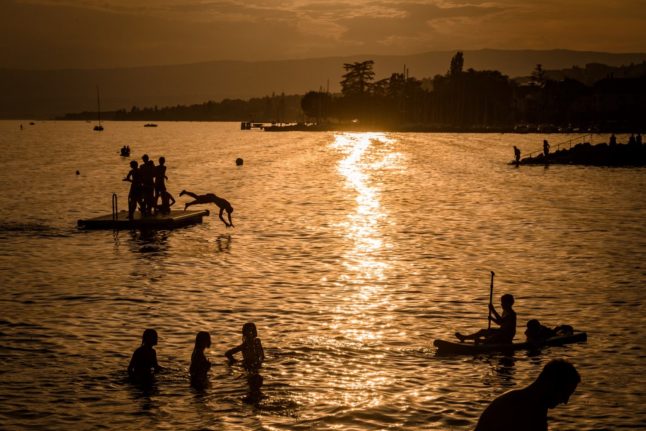There has been no respite from the extreme heat in Switzerland this week.
On Wednesday, a red level 4 ‘high danger’ heat warning was issued by MeteoSwiss in parts of southern and western Switzerland, while an orange level 3 ‘considerable danger’ alert was announced for large swathes of the country, as seen below.

Temperatures up to 37C were expected in Geneva on Wednesday, while it was due to hover around 35C in other areas. In Zurich highs of 33C were forecast.
READ ALSO: What Swiss employees need to know about working in a heatwave
MeteoSwiss said that a temperature record for the second half of August was recorded on Tuesday at several locations, including in Zurich (34.7C) and Geneva (36.7).
Meanwhile, the highest ever August temperature was recorded at the weather station in Disentis, Graubünden, where the mercury hit 32.8C.
#Temperaturrekord für die zweite Augusthälfte an diversen Standorten. Dazu eine Auswahl quer durch die #Schweiz. In Disentis wurde mit 32.8 Grad gar die höchste Augusttemperatur überhaupt an dieser Station registriert. Fotos: M. Grundlehner, Meteomeldungen/App. pic.twitter.com/ulPh8IoqN0
— MeteoSchweiz (@meteoschweiz) August 22, 2023
Temperatures have not dropped below 30C during the day in many places since last Friday,
And there have also been ‘tropical nights’ – when the temperature doesn’t fall below 20C during the night, making it very uncomfortable to sleep.
READ ALSO: Switzerland’s official advice on how to protect yourself in a heatwave
But the heatwave is due to end soon.
On Friday it will get ever so slightly cooler with a maximum of 30C in Zurich and 32C in Geneva.
On Saturday temperatures are expected to fall dramatically, with around 22C forecast in the north.
In the south, the mercury is likely to dip under 30C at the weekend – Lugano is forecast to see 28C and Geneva 25C. But heavy showers and thunderstorms are expected all over the country, especially in the southwest.
From Sunday on, it will be even cooler – in Zurich it will barely reach 20C during the day, and in Bern just 19C.
And in the south, too, the hot summer will take a break: Geneva and Sion will see a maximum of 22C, while Lugano will be warmest at 24C. Again, showers are expected.
According to MeteoSwiss, the weather development from Monday onwards is quite uncertain, but it looks like it will be cooler for a while.




 Please whitelist us to continue reading.
Please whitelist us to continue reading.
Member comments